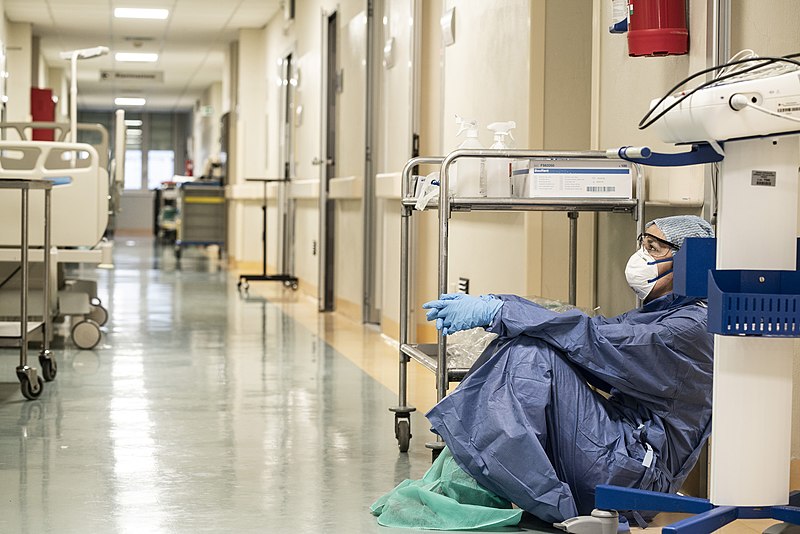Top Doc: “I Am At a Loss… I Honestly Don’t Know What to Say Anymore…”
As Hospitalizations and Deaths Skyrocket, Ansorg Laments Continued Disregard of Health Orders

Throughout the coronavirus pandemic, Santa Barbara County officials have maintained a unified public front of careful warnings and cautious optimism. But Tuesday afternoon, as COVID-19 infections, hospitalizations, and deaths skyrocketed to new record levels, Dr. Henning Ansorg, the county’s public health officer, delivered remarks that dripped with frustration and despair.

“In light of our current situation, I am at a loss,” he said during a media-only Zoom call. “I honestly don’t know what to say anymore. Many people are blatantly disregarding all warnings. There’s a lot of travelling, a lot of mixing and mingling and not wearing masks.”
“I understand that people are tired of the pandemic,” Ansorg continued. “However, denial of the facts will only make things worse.” Those facts are as follows:
Since the Thanksgiving holiday, when an untold number of people chose to ignore public health orders to stay home, active COVID-19 cases in Santa Barbara County have leaped from around 300 to a current 2,105.
Hospitalizations spiked from the low-teens to 172.
The ICU capacity has plummeted to below 1 percent. For the first time since the start of pandemic, ICU surge beds are also now in use, with 12 currently occupied.
In the last 48 hours, 13 people have died, far more than any other two-day period. A total of 173 have lost their lives to COVID-19.
And the grim trend is certain to continue, Ansorg went on, as new infections from Christmastime trips and gatherings catch up with the rest of the population. “Let’s face it,” he said, “our COVID situation in Santa Barbara County is dire.”
The testing positivity rate is now at 16 percent, double the threshold for what is considered widespread transmission; 76 outbreaks were reported in businesses and congregate living facilities in December alone.
Get the top stories in your inbox by signing up for our daily newsletter, Indy Today.
Hospitals are now preparing to implement “crisis care” protocols, Ansorg explained, “meaning that a person with urgent health needs other than COVID cannot receive the appropriate care they could normally expect.” As an example, he said, “If someone suffers a brain bleed and could be saved by an expert performing a procedure, this may no longer be possible because the hospitals are overbooked with COVID patients.”
The recent arrival of vaccines for health workers was a welcome bit of good news, Ansorg acknowledged. Of the 16,775 doses allocated to Santa Barbara County, 54 percent have so far been delivered and administered, a higher proportion than what has been reported statewide. However, he said, it will take many more months before widespread distribution is possible.
By February, officials hope they can offer the vaccine to people 75 and older, as well as essential workers in the food, agriculture, education, and emergency services sectors. Into March, doses are expected to be available for people 65 to 74 with underlying health conditions; transportation, construction, and manufacturing workers; and homeless and incarcerated individuals. Next up, into late spring, are younger people with underlying health issues as well as water, defense, tech, financial, and communications employees. After that is everyone else.
Officials say they’re working fast and furious to ramp up capacity with the goal of administering 1,000 doses a day by next month. Learn more and find your place in line at publichealthsbc.org/vaccine/.
Ansorg predicted that in the next two to three weeks, Santa Barbara’s health care apparatus is likely to confront the same systemwide overload Los Angeles is currently experiencing, where people with acute medical needs, COVID or otherwise, are no longer being admitted to hospitals if they don’t have a high probability of survival. “Unfortunately, I see that for us in the future,” he said. “It’s actively being discussed with our hospital partners.”
Ansorg also anticipated that lockdown precautions will continue into the fall. But they may be lifted sooner, he said, if more people abide by the health orders, including that those who must travel outside the county are required to quarantine for 10 days upon their return. Very few people have adhered to that, he said. If the virus variant, which reared its head in Southern California this week, makes it up to Santa Barbara, the six-foot social distancing requirement will likely have to expand, he said.
In the meantime, Ansorg intoned, some behaviors are more risky than others. Traveling and gathering with a group, especially while not wearing a mask, is extremely ill-advised. But walking with a friend or household member, keeping distance from others and always wearing a mask, is much safer.
As the virus continues to spread nearly exponentially, these choices have even greater consequences, he said. “Please make the right choices.”
At the Santa Barbara Independent, our staff is working around the clock to cover every aspect of this crisis — sorting truth from rumor. Our reporters and editors are asking the tough questions of our public health officials and spreading the word about how we can all help one another. The community needs us — now more than ever — and we need you in order to keep doing the important work we do. Support the Independent by making a direct contribution or with a subscription to Indy+.



You must be logged in to post a comment.